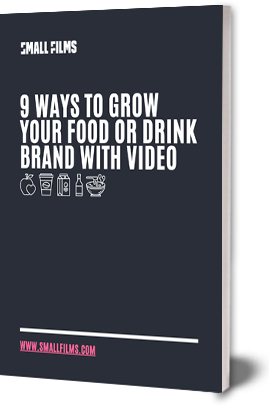When it comes to social media, one thing is a given: TikTok isn’t a fad. The platform exploded during the first lockdown and now has 800 million users worldwide. On top of that, it has been downloaded more than two billion times.
People have found fame on the platform, using its 60-second video clips to provide easily digestible, lighthearted content. And Brands have taken note, with everyone from Chipotle to The Washington Post using TikTok to ignite a spark with their audience.
It offers a pathway for brands to tap into younger demographics and strike a chord, whether you’re in the business of food and beverage or serving the public with breaking news. But how should you approach TikTok if you’re unfamiliar with the platform?
First-hand insights from a pro
As part of Small Films’ Food and Drink Marketing Month, we invited Timothy Armoo, CEO of Fanbytes, a leading influencer marketing agency that creates Generation Z content (TikTok’s primary demographic), to share some of his insights.
We’ve taken Timothy’s wise words and laid them out below. There are plenty of tips on how you can approach TikTok and create a strategy that helps you reach new audiences and gain more traction. So read on, and find out everything you need to know about using TikTok for your business.
Actually useful stuff you can use to win on TikTok
Right off the bat, it’s important to note that whenever there’s a new trend on the internet, a steady stream of people jump on the bandwagon and share their advice as if they are seasoned pros. When in fact, all they’re doing is regurgitating basic information that doesn’t dive deeper into the how of the new craze.
That’s certainly the case with TikTok, and something this article avoids. Instead, this guide looks at two key questions most marketing managers want answers to: what is the best content for TikTok and how do you run campaigns on TikTok?
What type of content should you create on TikTok?
The TikTok algorithm
Before flexing your creative chops and making content for audiences, it’s important to understand how TikTok’s algorithm works. The best way of doing this centres around following three primary principles found on most social media websites:
- Show more content related to your interests – the more content of interest that a social media platform can serve to you, the more engaged you will be with the platform. This leads to…
- Spending more time on the app – the longer you spend on the app, the more a social media platform can learn your habits about the type of content you like so they can…
- Serve you more ads – social media platforms make their money from ads, and it’s in their best interest to serve you with the kind of advertisements that will engage you.
TikTok, in particular, has become extremely proficient at showing its audience content related to its interests. Let’s say you start using the platform to watch food-related videos. TikTok will flood your account with more food content, using its algorithm to personalise the content you see and keep you coming back to the app.
Understanding TikTok as a marketer
From a marketing perspective, the goal is to show more content that people find interesting. And while that might sound like an obvious suggestion, it’s one of the areas where brands often fall short on social media because they complicate matters.
One of the biggest misconceptions people have about TikTok and social media at large is about the importance of going viral across the entire platform. Instead, the focus should be on picking a specific niche within TikTok’s ecosystem that lets you delve deeper to build better content.
Therefore, if you’re a food & beverage brand, the goal shouldn’t be to master the whole of TikTok; it’s about connecting with the platform’s community of food and drink lovers. Profiles don’t go viral unless you’re an influencer or celebrity – instead, it’s the videos that perform well, and TikTok’s algorithm favours videos over profiles.
TikTok’s content funnel
We’ve established that it’s more about creating content for your community rather than for the whole of TikTok, and that essentially means starting small. As a food & beverage brand, one of the avenues that may be available to you is the use of recipe creations. Using these, you can see how they resonate with your audience.
If the food & beverage community takes to your recipes, TikTok will start showing videos to people similar to those in your community. And if that goes down well, your videos will start showing on the For You page on TikTok, which is where all the best content picked up by the algorithm goes.
Circling back to the TikTok algorithm
Interacting with content in your community means you’re “warming” the algorithm – it’s the stage where you influence it the most. Let’s say you’re a vegan brand and want to grow your TikTok presence. You’d start by viewing and commenting on other vegan accounts, which tells TikTok that you’re interested in the vegan community. This is warming the algorithm.
Then you begin to feed the algorithm by creating content feeding into the kind of stuff you’ve already interacted with. This lets TikTok know that you’re an active member of that community, at which point it will start serving audiences with your similar content.
Ensuring organic success on TikTok
There are four pillars to ensuring TikTok success and keeping track of how the algorithm works. These four traits tell the algorithm that your content is successful, to which it will start expanding the pool of people who can see your videos.
- Watch time – are people watching your videos to the end, or do they stop before it finishes?
- Rewatch rate – how many people watch your video at least twice, if not more?
- Share rate – are people engaging with your videos enough that they want to share them with others?
- Comments – do viewers feel the need to comment on your videos after watching them?
Understanding the dynamics behind these four traits will help you navigate TikTok and its algorithm, so you can produce the type of content your audience wants. It will also help you better understand how to create good content.
What is good content?
So the primary question now centres around “what constitutes good content?”. Answering that is slightly trickier, as only you and people deeply connected to your business will know about the brand and what makes it tick. However, that’s not to say there aren’t some tried and tested formulas you can lean on.
Creating “useful content”, such as hacks like “xx of the best” or “how-to” guides is usually a good place to start – just remember that TikTok videos are only 60 seconds and your content should be concise and to the point.
You can be funny or aspirational if the fit is there, but ultimately it’s about resonating with your audience. And once you have a grasp over what your audience wants and start producing regular content, you can branch out and work with influencers to optimise your content.
How do I run influencer campaigns on TikTok?
Why influencers?
Like all social media platforms, the role of influencers has evolved over the last few years. Platforms like Instagram and TikTok are especially influencer-led, and the right collaboration can enhance your brand’s standing – but it needs to be organic.
Understanding the frameworks
Getting results is the primary goal of any influencer marketing on TikTok, and there are a few components worth taking into account to understand your campaign needs better and achieve the desired outcome.
Influencer retargeting
For many brands, successfully reaching an audience on TikTok requires authenticity, especially if you’re product-led. The content should be more about the video rather than wheeling an influencer out to say flattering things about your product.
The best way to do this is with influencer retargeting, which involves creating an organic influencer campaign and tying it to a paid ad that directly drives conversion. That means using influencers as the creative, which allows a more native approach and leads to more inclusive content. When done right, the creative becomes the most important aspect, which, in turn, powers the brand behind the campaign.
Leverage trends
Many brands are quick to create their own hashtag, but using existing trends is a smart way to leverage other well-performing content. Brands who successfully start their own hashtags are already well established and need deep pockets to ensure it becomes part of the TikTok lexicon.
Whereas, leveraging current trends can yield better results. However, it’s important to make the distinction between viral content and growing content. The goal is to ride growing content and be part of it when it goes viral, rather than hitching onto the back of something that’s already exploded.
Episodic content
Perhaps one of the most underrated aspects of TikTok is how episodic content feeds into watch times and gets people spending more time on your brand’s page. It’s a smart way for you to achieve results and tell TikTok to get people circling back to you.
One way to do this as a food & beverage brand may involve creating a dish over the course of several videos. It has that cliffhanger element and keeps coming back for more as they want to see the entire recipe.
How influencer campaigns fit into the broader picture
Tiktok serves a purpose in two primary ways: a destination for driving sales and a source for engaging and interesting content. With the latter, you can use the platform as the primary source for content and then promote it on other social media platforms with superior targeting to help drive more conversion.
The results of this approach can turbocharge engagement and your bottom line, with some brands seeing as much as 50 per cent conversion rates and return on ad spend of up to 10 times the initial cost.
Summary
Whether you’re using TikTok to drive direct sales or build your brand’s following across all of social media, Timothy’s tips can put you on the right track and help you go deeper under the bonnet of one of the fastest-growing platforms on the internet. And you can use these insights to build a successful TikTok following for your food & beverage brand by creating high-level content that satisfies the algorithm and delights your audience.
Find out more about Timothy Armoo and Fanbytes
George Hughes is a former television Director and the Founder of video marketing agency Small Films. His company helps brands to communicate with a wider audience using strategic video content.
Want a professional hand in creating compelling, authoritative video content as part of your marketing? Get in touch today.






